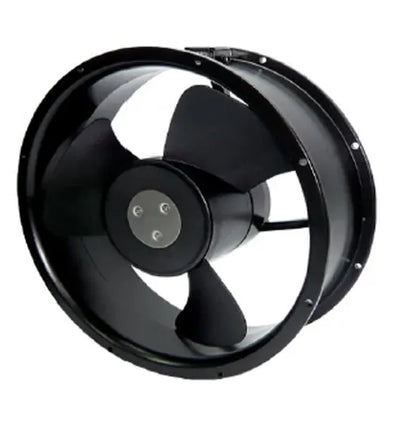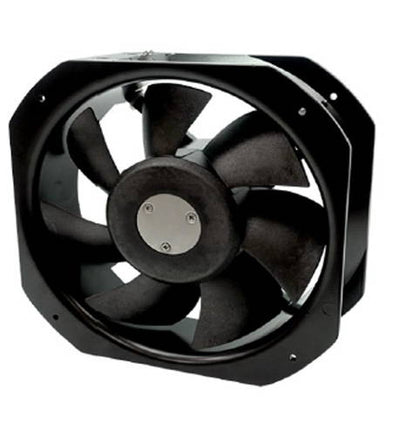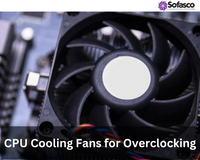Industrial fans such as axial and centrifugal fans are designed to move large volumes of air or at high speeds. They are an essential part of many industrial and commercial settings, such as factories, warehouses, and stadiums.
However, like any piece of machinery, industrial fans can fail due to several reasons. When this happens, it can cause major problems for the business or facility that relies on them. If your centrifugal fan is not working as efficiently as it should be, there are a few troubleshooting steps you can take to try and regain its efficiency. First, check to see if the blades are damaged or dirty. If they are, clean or replace them as needed. Next, check the bearings and make sure they are properly lubricated. Similarly, there are many more cooling fan troubleshooting tips that the user can implement during their service period. In this post, we will discuss some of the potential causes of industrial fan failure and what you can do to prevent them.

High-performance AC axial fans with die-cast aluminum housing, glass-reinforced impeller, and long-life ball or sleeve bearings. Ideal for industrial cooling applications.

Durable AC axial fan with thermally protected capacitor motor, aluminum housing, and glass-reinforced impeller. Suitable for commercial and industrial systems.
Reliable Tips For AC Fans Troubleshooting
When it comes to centrifugal fan troubleshooting, there are definitely some tried-and-true methods that can help you get to the bottom of the problem. But it's also important to remember that every fan is different and that there is certainly an element of trial and error involved in troubleshooting. With that said, there are some basic steps you can take for axial fan troubleshooting. First, check the motor and make sure it is receiving the correct voltage. Next, you can inspect the fan blades for any damage or debris. Finally, check the fan itself for any signs of wear or damage. The other major problems and their respective troubleshooting tips are mentioned below.
1. Problem: Humming Sound from the Motor
Causes:
There are many causes of the humming sound generated by the motor of the centrifugal fan when it is running. The most common cause is that the motor is not properly aligned. If the motor is not properly aligned, the blades of the fan will hit the housing of the fan, causing a vibrating sound. Other causes of the humming sound can be loose fan blades, a loose motor mount, an incorrect electrical supply, an overloaded motor, or a problem with the bearings in the motor.
Solutions:
- Check to see if the blades are installed correctly: If they are not, they can cause the motor to vibrate and produce a humming noise.
- Check the tension of the belts: If the belts are too loose, they can also cause the motor to vibrate and produce a humming noise.
- Check the alignment of the motor: Misalignment of the motor can also cause it to vibrate and produce a humming noise.
- Check if the supply phases are correct.
2. Problem: Overheating
Causes:
If your axial fan is overheating, it could be due to several factors. The most common cause of overheating is a build-up of dust and debris on the fan blades. This can cause the fan to work harder to move the air, which can lead to overheating. Another possible cause of overheating is a problem with the motor. If the motor is working harder than it should, it can cause the fan to overheat. The other factors that can contribute to centrifugal fan overheating, include blockages in the airflow, incorrect voltage, or blocked cooling vents on motor shrouds
Solutions:
- Check the airflow: If the airflow is blocked, it can cause the fan to overheat.
- Check the fan blades: If the blades are damaged, they may not be able to move the air effectively, causing the fan to overheat.
- Clean motor: Clean dirt and obstructions from cooling vents.
- Check the fitment of the cooling fan.
- Check the motor: If the motor is damaged, it may not be able to spin the blades correctly, causing the fan to overheat.
- Check the bearings: If the bearings are damaged, they may not be able to rotate the fan.
3. Problem: Excessive Vibration
Causes:
Some of the most common causes of excessive vibration in centrifugal fans include unbalanced blades, worn bearings, misaligned housing, and damaged impeller or bent motor shaft.
Solutions:
- Check to see if the fan blades are damaged or out of balance: If so, you'll need to replace the blades or balance them accordingly.
- Check the alignment of the fan: The fan must be properly aligned with the shaft it is mounted on. If it is not, you need to realign it.
- Check if the fan housing is damaged: This may cause excessive vibration. In this case, you need to replace the housing.
- Lastly, make sure that the fan is firmly mounted in place.
In addition to the above, you can perform the below steps:
- Clean the blades of the fan for any foreign objects that may be causing excessive vibration.
- Check the blades for any cracks, chips, or other damage.
Although failures can't be avoided, investing in good quality industrial fans helps to evade premature failure. When it comes to industrial fans, quality is important. Cheap fans may seem like a good deal at first, but they will eventually break down and need to be replaced. This can be costly in the long run, so it's better to invest in a good quality fan that will last from reputed sources such as Sofasco.












